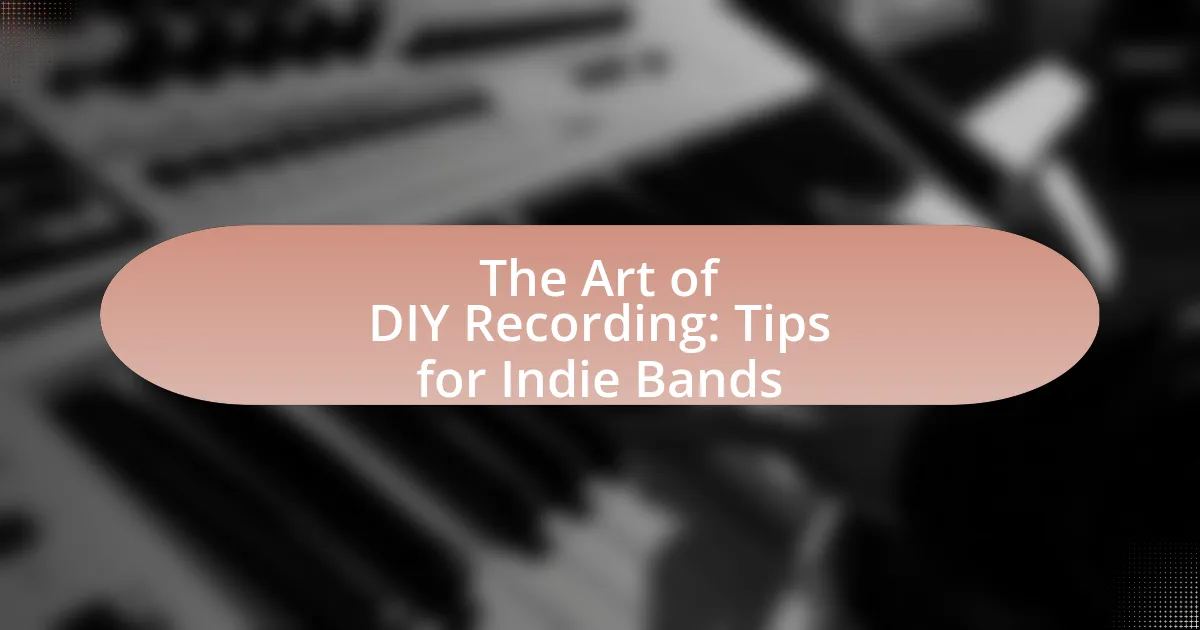DIY recording for indie bands is the practice of independently producing music without professional studio involvement, allowing for creative control and cost savings. This article explores the differences between DIY and professional studio recording, highlighting the advantages and challenges indie bands face in the DIY process. It discusses essential equipment, techniques for optimizing recording environments, and best practices for achieving high-quality sound. Additionally, the article examines the impact of technology and the internet on DIY recording, providing practical tips and resources for indie bands to enhance their recording efforts.

What is DIY Recording for Indie Bands?
DIY recording for indie bands refers to the practice of independently producing music without the involvement of a professional recording studio. This approach allows bands to have full creative control over their sound, budget, and production timeline. Many indie bands utilize affordable recording equipment and software, such as digital audio workstations (DAWs), to capture their music at home or in informal settings. The rise of accessible technology has made it possible for artists to produce high-quality recordings, enabling them to distribute their music through platforms like Bandcamp and SoundCloud. This trend is supported by statistics showing that a significant percentage of independent musicians now choose DIY methods to record and release their work, reflecting a shift in the music industry towards self-sufficiency and artistic autonomy.
How does DIY recording differ from professional studio recording?
DIY recording differs from professional studio recording primarily in terms of equipment quality, expertise, and production environment. DIY recording typically utilizes consumer-grade equipment and software, which may lack the fidelity and features of professional studio gear, while professional studios are equipped with high-end microphones, mixing consoles, and acoustic treatment designed to optimize sound quality. Additionally, professional studios often employ experienced sound engineers who provide technical expertise and creative input, enhancing the overall production quality. In contrast, DIY recording relies on the artist’s knowledge and skills, which can lead to varying results in sound quality and production value.
What are the advantages of DIY recording for indie bands?
DIY recording offers indie bands several advantages, including cost savings, creative control, and flexibility. By recording independently, bands can significantly reduce expenses associated with studio time, which can often exceed thousands of dollars. This financial freedom allows them to allocate resources toward other aspects of their music, such as marketing or touring.
Moreover, DIY recording grants bands complete creative control over their sound and production choices, enabling them to experiment without the constraints typically imposed by record labels or producers. This autonomy fosters artistic expression and can lead to a more authentic representation of their music.
Additionally, the flexibility of DIY recording allows bands to work at their own pace, accommodating their schedules and creative processes. They can record whenever inspiration strikes, leading to a more organic and spontaneous creation of music. These advantages collectively empower indie bands to produce high-quality recordings that reflect their unique identity and vision.
What challenges do indie bands face when recording DIY?
Indie bands face several challenges when recording DIY, including limited access to professional equipment, lack of technical expertise, and insufficient funding. Limited access to high-quality recording gear can hinder sound quality, as many indie bands may rely on basic equipment that does not capture the full range of their music. Additionally, without technical expertise, bands may struggle with mixing and mastering, leading to a less polished final product. Insufficient funding often restricts the ability to hire professionals for guidance or to invest in better equipment, which can further complicate the recording process. These challenges collectively impact the overall quality and production value of the music created by indie bands.
Why is DIY recording becoming popular among indie bands?
DIY recording is becoming popular among indie bands primarily due to the accessibility of affordable recording technology. Advances in software and hardware have enabled musicians to produce high-quality recordings from home, eliminating the need for expensive studio time. According to a 2021 survey by the Music Industry Research Association, over 70% of independent artists reported using home studios for their recordings, highlighting a significant shift towards self-production. This trend allows indie bands to maintain creative control over their music and reduce costs, making it an appealing option in a competitive industry.
How has technology influenced the rise of DIY recording?
Technology has significantly influenced the rise of DIY recording by providing accessible tools and platforms for musicians. The advent of affordable recording software, such as GarageBand and Audacity, along with high-quality microphones and audio interfaces, has enabled artists to produce professional-sounding music from home. Additionally, the proliferation of online distribution platforms like Bandcamp and SoundCloud allows independent musicians to share their work globally without the need for traditional record labels. This democratization of music production and distribution has led to a surge in DIY recording, empowering artists to take control of their creative processes and reach audiences directly.
What role does the internet play in DIY recording for indie bands?
The internet serves as a crucial platform for DIY recording among indie bands by providing access to affordable recording tools, distribution channels, and collaborative opportunities. It enables musicians to utilize software like GarageBand or Audacity for recording and editing music without the need for expensive studio time. Additionally, platforms such as Bandcamp and SoundCloud allow indie bands to distribute their music directly to listeners, bypassing traditional record labels. The internet also facilitates collaboration through file-sharing services and social media, allowing artists to connect with producers and other musicians globally. This democratization of music production and distribution has significantly lowered barriers for indie bands, fostering a vibrant and diverse music scene.

What essential equipment do indie bands need for DIY recording?
Indie bands need essential equipment for DIY recording, including a digital audio workstation (DAW), audio interface, microphones, headphones, and studio monitors. A DAW, such as Ableton Live or Pro Tools, allows for recording and editing audio tracks. An audio interface converts analog signals to digital, ensuring high-quality sound input. Microphones capture vocals and instruments, with dynamic and condenser types serving different purposes. Headphones provide accurate monitoring during recording, while studio monitors deliver a true representation of the mix. This equipment is crucial for achieving professional-sounding recordings in a home studio setup.
What are the key components of a DIY recording setup?
The key components of a DIY recording setup include a computer, audio interface, microphones, headphones, and digital audio workstation (DAW) software. A computer serves as the central hub for recording and editing audio, while an audio interface converts analog signals from microphones into digital data for the computer. Microphones capture sound, and headphones allow for monitoring during recording. DAW software provides the platform for recording, editing, and mixing audio tracks. Each component is essential for achieving high-quality recordings in a DIY environment.
How do microphones impact the quality of DIY recordings?
Microphones significantly impact the quality of DIY recordings by determining the clarity, detail, and overall fidelity of the sound captured. The type of microphone used, such as dynamic or condenser, influences how well it picks up different frequencies and sound sources. For instance, condenser microphones are often preferred for vocals and acoustic instruments due to their sensitivity and ability to capture high-frequency details, while dynamic microphones are more robust and suitable for loud sound sources like drums. Research indicates that the choice of microphone can affect the signal-to-noise ratio, with higher-quality microphones providing a cleaner sound with less background noise, thus enhancing the recording quality.
What software options are available for DIY recording?
Various software options are available for DIY recording, including Digital Audio Workstations (DAWs) such as Audacity, GarageBand, Reaper, and Ableton Live. Audacity is a free, open-source software that supports multi-track recording and editing, making it accessible for beginners. GarageBand, available on macOS and iOS, offers a user-friendly interface with a range of virtual instruments and loops. Reaper is a cost-effective DAW that provides extensive features for audio and MIDI recording, editing, and mixing. Ableton Live is favored for its real-time performance capabilities and is popular among electronic music producers. These software options cater to different skill levels and recording needs, ensuring that indie bands can find a suitable solution for their projects.
How can indie bands optimize their recording environment?
Indie bands can optimize their recording environment by controlling acoustics, utilizing quality equipment, and ensuring proper organization. Controlling acoustics involves using soundproofing materials like foam panels and carpets to minimize unwanted noise and echoes, which enhances sound clarity. Utilizing quality equipment, such as microphones and audio interfaces, ensures that the recorded sound is of high fidelity, which is crucial for professional-sounding tracks. Proper organization of the recording space, including cable management and equipment placement, facilitates a smoother recording process and reduces distractions. These strategies collectively contribute to a more effective and efficient recording environment for indie bands.
What acoustic treatments can improve sound quality in a DIY space?
Acoustic treatments that can improve sound quality in a DIY space include absorption panels, bass traps, and diffusers. Absorption panels, typically made from foam or fiberglass, reduce sound reflections and echoes, enhancing clarity. Bass traps, placed in corners, specifically target low-frequency sounds, preventing muddiness in recordings. Diffusers scatter sound waves, maintaining a lively acoustic environment while minimizing harsh reflections. Research indicates that proper acoustic treatment can lead to a 50% improvement in sound quality, making these treatments essential for effective DIY recording setups.
How does room size and shape affect recording quality?
Room size and shape significantly influence recording quality by affecting sound waves’ behavior within the space. Larger rooms tend to produce a more spacious sound with better natural reverb, while smaller rooms can lead to muddiness and excessive reflections. The shape of the room also plays a crucial role; irregularly shaped rooms can help diffuse sound waves, reducing standing waves and echoes, whereas rectangular rooms may create problematic resonances. Research indicates that room dimensions can alter frequency response, impacting clarity and tonal balance, which is essential for high-quality recordings.

What techniques can indie bands use to enhance their DIY recordings?
Indie bands can enhance their DIY recordings by utilizing techniques such as proper microphone placement, layering tracks, and employing digital audio workstations (DAWs) effectively. Proper microphone placement ensures optimal sound capture, as positioning microphones close to sound sources can reduce unwanted noise and enhance clarity. Layering tracks allows bands to build a richer sound by recording multiple takes of the same instrument or vocal, which can be mixed to create depth. Additionally, using DAWs like Ableton Live or Pro Tools enables bands to edit, mix, and apply effects, providing professional-quality results. These techniques are supported by the fact that many successful indie recordings have been achieved using similar methods, demonstrating their effectiveness in producing high-quality music.
How can bands effectively layer tracks in their recordings?
Bands can effectively layer tracks in their recordings by utilizing techniques such as panning, volume adjustments, and frequency separation. Panning involves placing different instruments in various positions within the stereo field, which creates a sense of space and clarity. Volume adjustments ensure that each track is balanced, allowing the most important elements to stand out without overpowering others. Frequency separation involves EQing each track to occupy its own sonic space, preventing muddiness and enhancing overall mix clarity. These methods are supported by industry practices, as seen in successful recordings where clarity and depth are achieved through thoughtful layering.
What are the best practices for recording vocals and instruments?
The best practices for recording vocals and instruments include ensuring proper acoustics, using high-quality microphones, and maintaining optimal recording levels. Proper acoustics can be achieved by treating the recording space with sound-absorbing materials to minimize reflections and background noise. High-quality microphones, such as condenser mics for vocals and dynamic mics for instruments, capture sound more accurately, enhancing the overall quality of the recording. Maintaining optimal recording levels, ideally peaking around -6 dB to -12 dB, prevents distortion and allows for better mixing later. These practices are supported by industry standards that emphasize the importance of a controlled environment and quality equipment in achieving professional-sounding recordings.
How can mixing and mastering improve the final product?
Mixing and mastering enhance the final product by ensuring clarity, balance, and professional quality in audio recordings. Mixing involves adjusting levels, panning, and applying effects to individual tracks, which creates a cohesive sound that highlights the strengths of each element. Mastering, the final step, optimizes the overall track for various playback systems, ensuring it sounds polished and consistent across different formats. According to a study by the Audio Engineering Society, properly mixed and mastered tracks can increase listener engagement and satisfaction, leading to a more favorable reception in the competitive music market.
What common mistakes should indie bands avoid in DIY recording?
Indie bands should avoid poor planning and lack of preparation in DIY recording. Effective planning includes setting clear goals for the recording session, such as deciding on the number of tracks, the desired sound, and the timeline. Additionally, not investing in quality equipment can lead to subpar recordings; using low-quality microphones or interfaces can compromise sound fidelity. Furthermore, neglecting to properly soundproof the recording environment can introduce unwanted noise, affecting the overall quality. Lastly, failing to allocate time for mixing and mastering can result in an unpolished final product, as these processes are crucial for achieving a professional sound.
How can poor planning affect the recording process?
Poor planning can significantly disrupt the recording process by leading to inefficient use of time and resources. When indie bands fail to outline clear objectives, they may encounter delays, resulting in rushed sessions that compromise sound quality. For instance, a study by the Berklee College of Music found that projects with a detailed pre-production plan completed recording sessions 30% faster than those without. Additionally, inadequate preparation can result in missed opportunities for creative input, as artists may not have enough time to experiment with arrangements or sound design, ultimately affecting the final product’s quality.
What are the pitfalls of neglecting sound quality during recording?
Neglecting sound quality during recording leads to poor audio fidelity, which can significantly diminish the overall impact of a musical project. When sound quality is compromised, listeners may experience distortion, muddiness, or a lack of clarity, making it difficult to appreciate the nuances of the music. Research indicates that high-quality recordings are essential for listener engagement; for instance, a study by the Audio Engineering Society found that listeners are more likely to connect emotionally with music that has clear and well-defined sound. Additionally, subpar sound quality can hinder an artist’s credibility and marketability, as industry professionals often prioritize polished recordings when considering new talent.
What are some practical tips for successful DIY recording?
To achieve successful DIY recording, ensure you have quality equipment, including a good microphone, audio interface, and headphones. Quality equipment significantly impacts sound clarity and overall production value. Additionally, create a suitable recording environment by minimizing background noise and using acoustic treatment, which can enhance the recording quality by reducing unwanted echoes and reflections.
Furthermore, plan your sessions meticulously by organizing your tracks and rehearsing beforehand, as this can streamline the recording process and improve efficiency. Utilize digital audio workstations (DAWs) effectively, as they provide essential tools for editing and mixing, allowing for a polished final product. Lastly, take breaks during long sessions to maintain focus and creativity, which is crucial for achieving the best results in your recordings.
How can indie bands stay organized during the recording process?
Indie bands can stay organized during the recording process by implementing a structured schedule and utilizing project management tools. Establishing a timeline for recording sessions, including specific goals for each session, helps ensure that all members are aligned and aware of their responsibilities. Tools like Trello or Asana can facilitate task assignments and track progress, allowing bands to manage their workflow efficiently. Research indicates that teams using project management software report a 20% increase in productivity, highlighting the effectiveness of these tools in maintaining organization.
What resources are available for learning DIY recording techniques?
Online platforms such as YouTube, Skillshare, and Coursera offer extensive resources for learning DIY recording techniques. YouTube features numerous channels dedicated to audio recording, providing tutorials on equipment setup, mixing, and mastering. Skillshare and Coursera host structured courses taught by industry professionals, covering topics from basic recording principles to advanced production techniques. Additionally, websites like Sound on Sound and Recording Magazine provide articles and guides that delve into specific recording methods and gear reviews, enhancing the learning experience for aspiring DIY recordists.


